《近代中国对外关系史 The History of Modern China's Foreign Relations》课程教学资源(PPT讲稿)Week 1 - Introduction
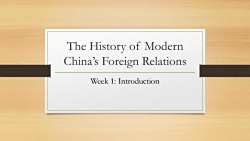
The History of Modern China's Foreign Relations Week 1:Introduction
The History of Modern China’s Foreign Relations Week 1: Introduction
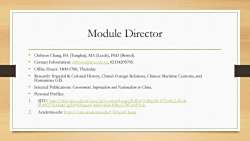
Module Director Chihyun Chang,BA (Tunghai),MA (Leeds),PhD (Bristol). Contact Information:chihyun @situ.edu.cn,02134205705. .Office Hours:1400-1700,Thursday. 。 Research:Imperial Colonial History,China's Foreign Relations,Chinese Maritime Customs,and Humanities GIS. .Selected Publications:Government,Imperialism and Nationalism in China. 。 Personal Profiles: 1. SITU:http://shss.situ.edu.cn/sites/id/content3.aspx?Infld=7cf0aa38-1f72-45e2-81e8- 0149f273e4fa&Ctgld=fdoaae6f-4dd0-4daf-83bc-b78f7c0291dc 2. Academia.edu:https://sit.academia.cdu/ChihyunChang
Module Director • Chihyun Chang, BA (Tunghai), MA (Leeds), PhD (Bristol). • Contact Information: chihyun@sjtu.edu.cn, 02134205705. • Office Hours: 1400-1700, Thursday. • Research: Imperial & Colonial History, China’s Foreign Relations, Chinese Maritime Customs, and Humanities GIS. • Selected Publications: Government, Imperialism and Nationalism in China. • Personal Profiles: 1. SJTU: http://shss.sjtu.edu.cn/sites/jd/content3.aspx?InfId=7cf0aa38-1f72-45e2-81e8- 0149f273e4fa&CtgId=fd0aae6f-4dd0-4daf-83bc-b78f7c0291dc 2. Academia.edu: https://sjtu.academia.edu/ChihyunChang
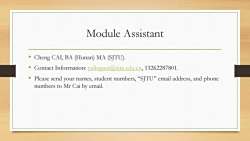
Module Assistant Cheng CAI,BA (Hunan)MA(SJTU) Contact Information:yulinguer @situ.edu.cn,13262287801. Please send your names,student numbers,"SJTU"email address,and phone numbers to Mr Cai by email
Module Assistant • Cheng CAI, BA (Hunan) MA (SJTU). • Contact Information: yulinguer@sjtu.edu.cn, 13262287801. • Please send your names, student numbers, “SJTU” email address, and phone numbers to Mr Cai by email
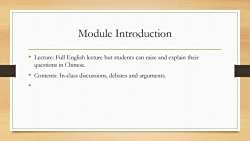
Module Introduction Lecture:Full English lecture but students can raise and explain their questions in Chinese. 。 Contents:In-class discussions,debates and arguments
Module Introduction • Lecture: Full English lecture but students can raise and explain their questions in Chinese. • Contents: In-class discussions, debates and arguments. •
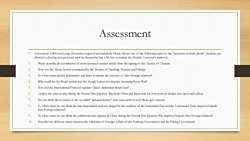
Assessment Assessment:3,000 word essay(foomotes required and included).Please choose one of the following topics or the"questions to think about".Students are allowed to develop any preferred topic by themselves but s/he has to acquire the Module Convener's approval 1 Please describe the constitution of most favoured country article from the signing of the Treaties of Tientsin. 2. How was the Treaty System constituted by the Treaties of Nanking,Tientsin and Peking? 3. To what extent did the indemnities and loans constrain the recovery of Sino-Foreign relations? 4. Why could the Six Board system and the Zongli Yamen not stop the incoming Boxer War? 5. How did the International Protocol regulate China's diplomatic behaviours? 6 Analyse the reasons why during the Second Sino-Japanese War both China and Japan wait for four yours to declare war upon each others. 7. Do you think the revisions of the so-called"unequal treaties"were successful or not?Please give reasons. 8. To what extent do you think the anti imperialistic activities staged by the coalition of the Nationalist Part and the Communist Party improve/impede Sino-Foreign relations? 9. To what extent do you think the collaborationist regimes in China during the Second Sino-Japanese War improve/impede Sino-Foreign relations? 10. Describe the different nature between the Ministries of Foreign Affairs of the Nanking Government and the Peking Government
Assessment • Assessment: 3,000 word essay (footnotes required and included). Please choose one of the following topics or the "questions to think about". Students are allowed to develop any preferred topic by themselves but s/he has to acquire the Module Convener's approval. 1. Please describe the constitution of most favoured country article from the signing of the Treaties of Tientsin. 2. How was the Treaty System constituted by the Treaties of Nanking, Tientsin and Peking? 3. To what extent did the indemnities and loans constrain the recovery of Sino-Foreign relations? 4. Why could the Six Board system and the Zongli Yamen not stop the incoming Boxer War? 5. How did the International Protocol regulate China's diplomatic behaviours? 6. Analyse the reasons why during the Second Sino-Japanese War both China and Japan wait for four yours to declare war upon each others. 7. Do you think the revisions of the so-called "unequal treaties" were successful or not? Please give reasons. 8. To what extent do you think the anti imperialistic activities staged by the coalition of the Nationalist Part and the Communist Party improve/impede Sino-Foreign relations? 9. To what extent do you think the collaborationist regimes in China during the Second Sino-Japanese War improve/impede Sino-Foreign relations? 10. Describe the different nature between the Ministries of Foreign Affairs of the Nanking Government and the Peking Government
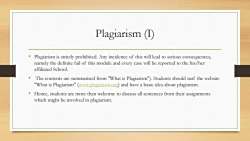
Plagiarism(④ 。 Plagiarism is strictly prohibited.Any incidence of this will lead to serious consequences, namely the definite fail of this module and every case will be reported to the his/her affiliated School. The contents are summarised from"What is Plagiarism").Students should surf the website "What is Plagiarism"(wwwplagiarismorg)and have a basic idea about plagiarism. .Hence,students are more than welcome to discuss all sentences from their assignments which might be involved in plagiarism
Plagiarism (I) • Plagiarism is strictly prohibited. Any incidence of this will lead to serious consequences, namely the definite fail of this module and every case will be reported to the his/her affiliated School. • The contents are summarised from "What is Plagiarism"). Students should surf the website "What is Plagiarism" (www.plagiarism.org) and have a basic idea about plagiarism. • Hence, students are more than welcome to discuss all sentences from their assignments which might be involved in plagiarism
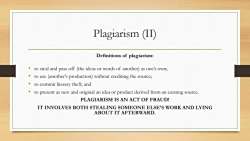
Plagiarism ID) Definitions of plagiarism: to steal and pass off(the ideas or words of another)as one's own; to use(another's production)without crediting the source; to commit literary theft;and to present as new and original an idea or product derived from an existing source. PLAGIARISM IS AN ACT OF FRAUD! IT INVOLVES BOTH STEALING SOMEONE ELSE'S WORK AND LYING ABOUT IT AFTERWARD
Plagiarism (II) Definitions of plagiarism: • to steal and pass off (the ideas or words of another) as one’s own; • to use (another's production) without crediting the source; • to commit literary theft; and • to present as new and original an idea or product derived from an existing source. PLAGIARISM IS AN ACT OF FRAUD! IT INVOLVES BOTH STEALING SOMEONE ELSE'S WORK AND LYING ABOUT IT AFTERWARD
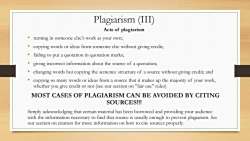
Plagiarism (IIT) Acts of plagiarism turning in someone else's work as your own; copying words or ideas from someone else without giving credit; failing to put a quotation in quotation marks; giving incorrect information about the source of a quotation; changing words but copying the sentence structure of a source without giving credit;and copying so many words or ideas from a source that it makes up the majority of your work, whether you give credit or not(see our section on"fair use"rules) MOST CASES OF PLAGIARISM CAN BE AVOIDED BY CITING SOURCES!!! Simply acknowledging that certain material has been borrowed and providing your audience with the information necessary to find that source is usually enough to prevent plagiarism.See our section on citation for more information on how to cite sources properly
Plagiarism (III) Acts of plagiarism • turning in someone else's work as your own; • copying words or ideas from someone else without giving credit; • failing to put a quotation in quotation marks; • giving incorrect information about the source of a quotation; • changing words but copying the sentence structure of a source without giving credit; and • copying so many words or ideas from a source that it makes up the majority of your work, whether you give credit or not (see our section on "fair use" rules) MOST CASES OF PLAGIARISM CAN BE AVOIDED BY CITING SOURCES!!! Simply acknowledging that certain material has been borrowed and providing your audience with the information necessary to find that source is usually enough to prevent plagiarism. See our section on citation for more information on how to cite sources properly
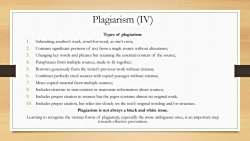
Plagiarism (IV) Types of plagiarism: 1.Submitting another's work,word-for-word,as one's own; 2. Contains significant portions of text from a single source without alterations; 3. Changing key words and phrases but retaining the essential content of the source; 4. Paraphrases from multiple sources,made to fit together; 5. Borrows generously from the writer's previous work without citation; 6. Combines perfectly cited sources with copied passages without citation; 7. Mixes copied material from multiple sources; 8. Includes citations to non-existent or inaccurate information about sources; 9. Includes proper citation to sources but the paper contains almost no original work; 10.Includes proper citation,but relies too closely on the text's original wording and/or structure. Plagiarism is not always a black and white issue. Learning to recognise the various forms of plagiarism,especially the more ambiguous ones,is an important step towards effective prevention
Types of plagiarism: 1. Submitting another’s work, word-for-word, as one’s own; 2. Contains significant portions of text from a single source without alterations; 3. Changing key words and phrases but retaining the essential content of the source; 4. Paraphrases from multiple sources, made to fit together; 5. Borrows generously from the writer’s previous work without citation; 6. Combines perfectly cited sources with copied passages without citation; 7. Mixes copied material from multiple sources; 8. Includes citations to non-existent or inaccurate information about sources; 9. Includes proper citation to sources but the paper contains almost no original work; 10. Includes proper citation, but relies too closely on the text’s original wording and/or structure. Plagiarism is not always a black and white issue. Learning to recognise the various forms of plagiarism, especially the more ambiguous ones, is an important step towards effective prevention. Plagiarism (IV)
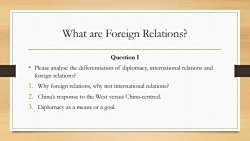
What are Foreign Relations? Question I Please analyse the differentiation of diplomacy,international relations and foreign relations? 1.Why foreign relations,why not international relations? 2.China's response to the West versus China-centred. 3.Diplomacy as a means or a goal
What are Foreign Relations? Question I • Please analyse the differentiation of diplomacy, international relations and foreign relations? 1. Why foreign relations, why not international relations? 2. China’s response to the West versus China-centred. 3. Diplomacy as a means or a goal
按次数下载不扣除下载券;
注册用户24小时内重复下载只扣除一次;
顺序:VIP每日次数-->可用次数-->下载券;
- 《近代中国对外关系史 The History of Modern China's Foreign Relations》课程教学资源(PPT讲稿)What’s the Battle of Shanghai:new trial to research Sino- Japanese War by GIS.pptx
- 《中国近代史专题研究》课程教学资源(团练、水师与军阀)教学大纲 Research Topics on Modern Chinese History Militia, Navy and Warlordism.docx
- 《中国近代史专题研究》课程教学资源(团练、水师与军阀)第8周 袁氏四年、強人政治(中华民国北洋时期:北洋军阀之起源、袁世凯和洪宪帝制).pptx
- 《中国近代史专题研究》课程教学资源(团练、水师与军阀)第9周 府院之爭,張勳復辟(中华民国北洋时期:两次府院之争、北洋之虎、和南北战争).pptx
- 《中国近代史专题研究》课程教学资源(团练、水师与军阀)第7周 新建陸軍與袁世凱的崛起(北洋新軍與袁世凱).pptx
- 《中国近代史专题研究》课程教学资源(团练、水师与军阀)第6周 八國聯軍和武衛軍覆滅.pptx
- 《中国近代史专题研究》课程教学资源(团练、水师与军阀)第5周 甲午戰爭和淮軍覆滅.pptx
- 《中国近代史专题研究》课程教学资源(团练、水师与军阀)第4周 捻亂、回變與團練勢力的擴大 The Muslim Uprising and the Nian Bandits.pptx
- 《中国近代史专题研究》课程教学资源(团练、水师与军阀)第3周 團練的興起與太平天國的覆滅.pptx
- 《中国近代史专题研究》课程教学资源(团练、水师与军阀)第2周 綠營的覆滅與太平天國的興起 THE TAIPING HEAVENLY KINGDOM AND CENTRAL TROOPS OF THE QING EMPIRE.pptx
- 《中国近代史专题研究》课程教学资源(团练、水师与军阀)第1周 導言 Introduction.pptx
- 《中国近代史专题研究》课程教学资源(团练、水师与军阀)第15周 安國軍與天下三分(第一次北伐、寧漢分裂、第二次北伐).pptx
- 《中国近代史专题研究》课程教学资源(团练、水师与军阀)第14周 攝政內閣(中華民國北洋政府時期:反奉戰爭、張吳和解、安國軍政府).pptx
- 《中国近代史专题研究》课程教学资源(团练、水师与军阀)第13周 臨時執政(中華民國北洋政府時期:段祺瑞復出、孫文逝世、北洋瓦解).pptx
- 《中国近代史专题研究》课程教学资源(团练、水师与军阀)第12周 曹錕當國(中華民國北洋時期:直系的崩潰).pptx
- 《中国近代史专题研究》课程教学资源(团练、水师与军阀)第11周 直系崛起.pptx
- 《中国近代史专题研究》课程教学资源(团练、水师与军阀)第10周 偃武修文與北洋分裂(中华民国北洋政府时期:大总统徐世昌、南北和谈、外蒙古复归、五四运动).pptx
- 上海交通大学:《城市文明的历史与未来》课程教学资源(讲义)现代城市文明的反思与展望.pdf
- 上海交通大学:《城市文明的历史与未来》课程教学资源(讲义)王权时代的欧洲城市.pdf
- 《近世中国历史与文化》课程教学资源(PDF参考电子书)陈学霖《刘伯温与哪吒城——北京建城的传说》.pdf
- 《近代中国对外关系史 The History of Modern China's Foreign Relations》课程教学资源(PPT讲稿)Week 10 - The Early Republic's Diplomatic Difficulties.pptx
- 《近代中国对外关系史 The History of Modern China's Foreign Relations》课程教学资源(PPT讲稿)Week 11 - China's Participation into the Global Order.pptx
- 《近代中国对外关系史 The History of Modern China's Foreign Relations》课程教学资源(PPT讲稿)Week 12 - The South Revolutionaries' Nationalistic Claims and Anti-Imperialistic Campaigns.pptx
- 《近代中国对外关系史 The History of Modern China's Foreign Relations》课程教学资源(PPT讲稿)Week 13 - The Nanjing Decade and the New Era of China's Diplomacy.pptx
- 《近代中国对外关系史 The History of Modern China's Foreign Relations》课程教学资源(PPT讲稿)Week 14 - The Second Sino-Japanese War, 1937-1941.pptx
- 《近代中国对外关系史 The History of Modern China's Foreign Relations》课程教学资源(PPT讲稿)Week 15 - The Pacific War, 1941-1945.pptx
- 《近代中国对外关系史 The History of Modern China's Foreign Relations》课程教学资源(PPT讲稿)Week 16 - The Collapse of the Nationalist Government.pptx
- 《近代中国对外关系史 The History of Modern China's Foreign Relations》课程教学资源(PPT讲稿)Week 2 - The Collision of the Chinese and British Empires, 1792-1816.pptx
- 《近代中国对外关系史 The History of Modern China's Foreign Relations》课程教学资源(PPT讲稿)Week 3 - The First Opium War and the Treaty of Nanking.pptx
- 《近代中国对外关系史 The History of Modern China's Foreign Relations》课程教学资源(PPT讲稿)Week 4 - The Second Opium War and the Reconfirmation of the Treaty System.pptx
- 《近代中国对外关系史 The History of Modern China's Foreign Relations》课程教学资源(PPT讲稿)Week 5 - The Self Strengthening Movement and the CMCS, 1861-1885.pptx
- 《近代中国对外关系史 The History of Modern China's Foreign Relations》课程教学资源(PPT讲稿)Week 6 - Tributary States and the Sino-Foreign Conflicts.pptx
- 《近代中国对外关系史 The History of Modern China's Foreign Relations》课程教学资源(PPT讲稿)Week 7 - The Partition of China and the Hundred Days' Reforms.pptx
- 《近代中国对外关系史 The History of Modern China's Foreign Relations》课程教学资源(PPT讲稿)Week 8 - The Boxer War and the International Protocol.pptx
- 《近代中国对外关系史 The History of Modern China's Foreign Relations》课程教学资源(PPT讲稿)Week 9 - The New Policies Reforms and the Anglo-Japanese Alliance.pptx
- 《近代中国对外关系史 The History of Modern China's Foreign Relations》课程教学资源(阅读材料)Anglo-Chinese Diplomacy in the Sir John Jordan and Yuan Shih-k'ai(1906-1920).pdf
- 《近代中国对外关系史 The History of Modern China's Foreign Relations》课程教学资源(阅读材料)Anglo-Chinese Diplomacy in the Sir John Jordan and Yuan Shih-k'ai(1906-1920).pdf
- 《近代中国对外关系史 The History of Modern China's Foreign Relations》课程教学资源(阅读材料)Revisiting the Chinese Maritime Customs Service, 1854 –1950.pdf
- 《近代中国对外关系史 The History of Modern China's Foreign Relations》课程教学资源(阅读材料)Cambridge History of China Vol. 11 Ch 4 THE MILITARY CHALLENGE(THE NORTH-WEST AND THE COAST).pdf
- 《近代中国对外关系史 The History of Modern China's Foreign Relations》课程教学资源(阅读材料)China in Revolution(he First Phase,1900-1913).pdf
